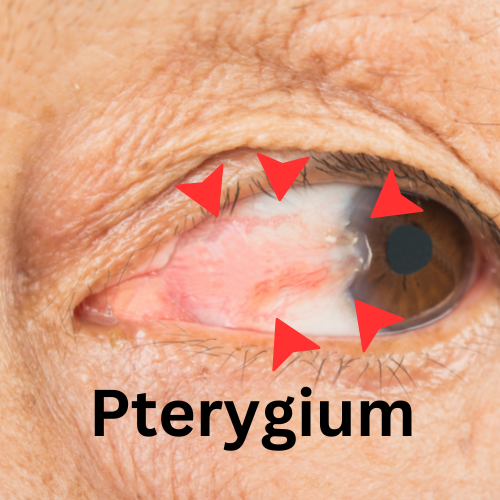What is a Pterygium?


Pterygium is pronounced “tr·i·jee·uhm”. There’s a silent “p”.
It is a noncancerous (benign), fleshy growth on the white part of the eye (conjunctiva). A pterygium can grow from either corner of the eye, but most often grows from the corner of the eye next to the nose. It can spread outward and can grow to cover the cornea and obscure vision.
A pterygium is typically a triangle-shaped growth, but the shape can vary. Sometimes a pterygium is only noticed when it has grown to cover a major part of the cornea and block the iris.
What does the name mean?
The originiation is a compound word joining the Greek “pteryga” meaning wing with the suffix “ium” which indicates a biological structure, so pterygium is a wing-like biological structure. The nickname for the condition is “surfer’s eye” because it is believed that the condition is brought on by repeated exposure to UV radiation.
Who is at risk for developing a pterygium?
Cumulative ultraviolet light exposure seems to be the major factor in developing a pterygium so people who have outdoor occupations who do not wear UV-protective eyeglasses have a higher risk of developing this growth than other groups. Being male and having dry eyes is also a contributing factor in developing a pterygium.
Repeated exposure to pollen, sand, smoke, wind, and dusty environments on a regular basis can also cause a pterygium on the conjunctiva or mucous membrane.
Signs and symptoms
Early signs and symptoms include:
- A slightly raised pink growth on your eye
- Red, irritated or swollen eyes
- Limited eye movement in the affected eye
- Dry eyes, itchy eyes or burning eyes
- Feeling like you have sand or grit is in your eye
- Teary eyes
- Blurred vision
Symptoms are usually mild and only in advanced cases is vision affected. If the pterygium grows over the cornea and covers the pupil it can block the vision or pull on the cornea and cause astigmatism.
How is pterygium diagnosed?
Your eye doctor can diagnose a pterygium during a comprehensive eye exam. Your eye doctor may also use corneal topography to map the curved surface of your cornea to help monitor the progression of your pterygium.
Treatments
Not all cases require treatment. Only in cases in which the pterygium grows so large that it blocks your vision is surgical removal recommended.
The treatment depends on the size of the growth. Smaller pterygiae are usually treated with artificial tears to lubricate the eyes or mild steroid eye drops to treat the swelling. A special contact lens may also be placed over the eye to offer protection from UV rays and other irritants.
Surgical treatments
If nonsurgical treatments do not relieve the symptoms and if the pterygium is affecting vision, surgery may be recommended. There are several surgical approaches for pterygium removal and they include:
- Removing only the pterygium.
- Removing the growth and placing a sheet of amniotic membrane over the affected area that will act as a bandage to help the eye heal.
- Removing the pterygium and covering the affected area with a healthy piece of conjunctiva (autograft surgery). The healthy conjunctiva is usually taken from behind the upper eyelid. This procedure is best for preventing the return of pterygium, but it’s a longer and more complex surgery.
If you have surgery, the chance of recurrence depends on the type of surgery you had and the amount of sun exposure after surgery.
Lower your risks
You can lower your risk of developing a pterygium, slow the growth of one you already have, or help prevent the return of one you had surgically removed by:
- Wearing 100% UVA and UVB sunglasses and a wide-brimmed hat when you’re in the sun to protect your eyes from ultraviolet light. Wear UV-protective sunglasses even on cloudy days.
- Use artificial tears to keep your eyes moist, especially if you live in a dry climate.
Gregory Scimeca, M.D.
Ophthalmologist and Medical Director
The Eye Professionals
Our Locations
